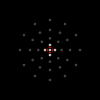Measurement of Retinal Sensitivity on Tablet Devices in Age-Related Macular Degeneration
- PMID: 26175959
- PMCID: PMC4497484
- DOI: 10.1167/tvst.4.3.13
Measurement of Retinal Sensitivity on Tablet Devices in Age-Related Macular Degeneration
Abstract
Purpose: We compared measurements of central retinal sensitivity on a portable, low-cost tablet device to the established method of microperimetry in age-related macular degeneration (AMD).
Methods: A customized test designed to measure central retinal sensitivity (within the central 1° radius) on a tablet device was developed using an open-source platform called PsyPad. A total of 30 participants with AMD were included in this study, and all participants performed a practice test on PsyPad, followed by four tests of one eye and one test of the other eye. Participants then underwent standardized microperimetry examinations in both eyes.
Results: The average test duration on PsyPad was 53.9 ± 7.5 seconds, and no significant learning effect was observed over the examinations performed (P = 1.000). The coefficient of repeatability of central retinal sensitivity between the first two examinations on PsyPad was ±1.76 dB. The mean central retinal sensitivity was not significantly different between PsyPad (25.7 ± 0.4 dB) and microperimetry (26.1 ± 0.4 dB, P = 0.094), and the 95% limits of agreement between the two measures were between -4.12 and 4.92 dB.
Conclusions: The measurements of central retinal sensitivity can be performed effectively using a tablet device, displaying reasonably good agreement with those obtained using the established method of microperimetry.
Translational relevance: These findings highlight the potential of tablet devices as low-cost and portable tools for developing and performing visual function measures that can be easily and widely implemented.
Keywords: age-related macular degeneration; iPad; microperimetry; visual function.
Figures




Similar articles
-
Home Monitoring of Retinal Sensitivity on a Tablet Device in Intermediate Age-Related Macular Degeneration.Transl Vis Sci Technol. 2018 Oct 29;7(5):32. doi: 10.1167/tvst.7.5.32. eCollection 2018 Sep. Transl Vis Sci Technol. 2018. PMID: 30386684 Free PMC article.
-
A Tablet-Based Retinal Function Test in Neovascular Age-Related Macular Degeneration Eyes and At-Risk Fellow Eye.Transl Vis Sci Technol. 2018 Mar 1;7(2):2. doi: 10.1167/tvst.7.2.2. eCollection 2018 Mar. Transl Vis Sci Technol. 2018. PMID: 29520334 Free PMC article.
-
Longitudinal changes in microperimetry and low luminance visual acuity in age-related macular degeneration.JAMA Ophthalmol. 2015 Apr;133(4):442-8. doi: 10.1001/jamaophthalmol.2014.5963. JAMA Ophthalmol. 2015. PMID: 25632841
-
Intrasession test-retest variability of microperimetry in age-related macular degeneration.Invest Ophthalmol Vis Sci. 2013 Nov 11;54(12):7378-85. doi: 10.1167/iovs.13-12617. Invest Ophthalmol Vis Sci. 2013. PMID: 24135753
-
Microperimetry in age-related macular degeneration: association with macular morphology assessed by optical coherence tomography.Br J Ophthalmol. 2019 Dec;103(12):1769-1776. doi: 10.1136/bjophthalmol-2018-313316. Epub 2019 Feb 1. Br J Ophthalmol. 2019. PMID: 30709810
Cited by
-
Portable Perimetry Using Eye-Tracking on a Tablet Computer-A Feasibility Assessment.Transl Vis Sci Technol. 2019 Feb 5;8(1):17. doi: 10.1167/tvst.8.1.17. eCollection 2019 Jan. Transl Vis Sci Technol. 2019. PMID: 30740267 Free PMC article.
-
Performance of a Smart Device over 12-Months for Home Monitoring of Patients with Intermediate Age-Related Macular Degeneration.J Clin Med. 2023 Mar 27;12(7):2530. doi: 10.3390/jcm12072530. J Clin Med. 2023. PMID: 37048613 Free PMC article.
-
Refinement and preliminary evaluation of two tablet-based tests of real-world visual function.Ophthalmic Physiol Opt. 2020 Jan;40(1):35-46. doi: 10.1111/opo.12658. Ophthalmic Physiol Opt. 2020. PMID: 31879994 Free PMC article.
-
CURRENT CONCEPTS AND MODALITIES FOR MONITORING THE FELLOW EYE IN NEOVASCULAR AGE-RELATED MACULAR DEGENERATION: An Expert Panel Consensus.Retina. 2020 Apr;40(4):599-611. doi: 10.1097/IAE.0000000000002768. Retina. 2020. PMID: 32032258 Free PMC article. Review.
-
Evaluation of the precision of contrast sensitivity function assessment on a tablet device.Sci Rep. 2017 Apr 21;7:46706. doi: 10.1038/srep46706. Sci Rep. 2017. PMID: 28429773 Free PMC article.
References
-
- Hogg RE,, Chakravarthy U. Visual function and dysfunction in early and late age-related maculopathy. Prog Retin Eye Res. 2006; 25: 249–276. - PubMed
-
- Johnson CA. Psychophysical measurement of glaucomatous damage. Surv Ophthalmol. 2001; 45 (suppl 3): S313–S318. - PubMed
-
- Monhart M. What are the options of psychophysical approaches in glaucoma? Surv Ophthalmol. 2007; 52: S127–S133. - PubMed
-
- Neelam K,, Nolan J,, Chakravarthy U,, Beatty S. Psychophysical function in age-related maculopathy. Surv Ophthalmol. 2009; 54: 167–210. - PubMed
-
- Roman AJ,, Schwartz SB,, Aleman TS,, et al. Quantifying rod photoreceptor-mediated vision in retinal degenerations: dark-adapted thresholds as outcome measures. Exp Eye Res. 2005; 80: 259–272. - PubMed
LinkOut - more resources
Full Text Sources
Other Literature Sources
Miscellaneous

